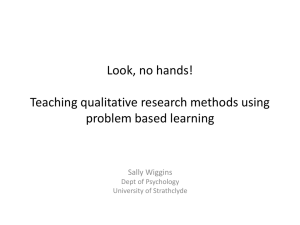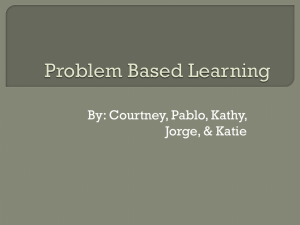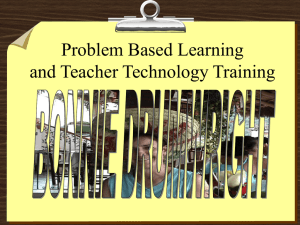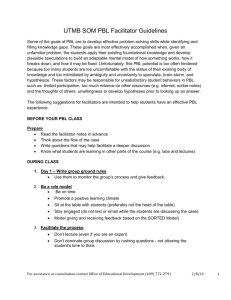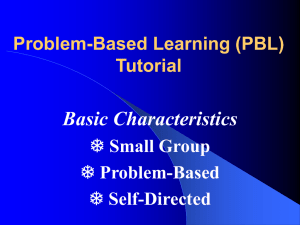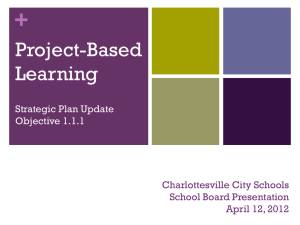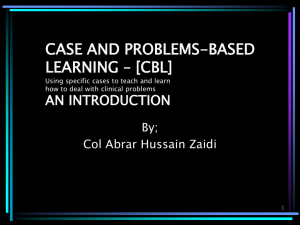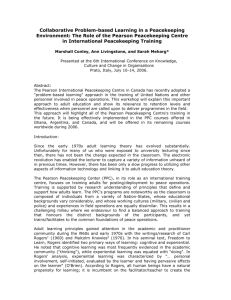Abstract - Australian Institute of Geoscientists
advertisement
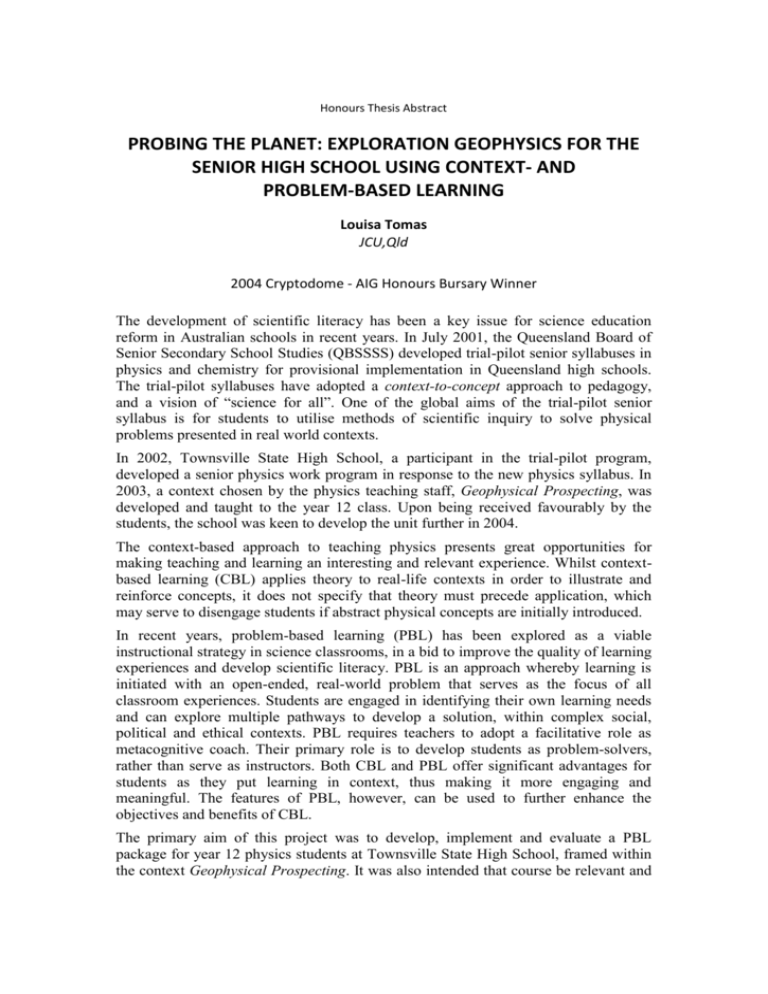
Honours Thesis Abstract PROBING THE PLANET: EXPLORATION GEOPHYSICS FOR THE SENIOR HIGH SCHOOL USING CONTEXT- AND PROBLEM-BASED LEARNING Louisa Tomas JCU,Qld 2004 Cryptodome - AIG Honours Bursary Winner The development of scientific literacy has been a key issue for science education reform in Australian schools in recent years. In July 2001, the Queensland Board of Senior Secondary School Studies (QBSSSS) developed trial-pilot senior syllabuses in physics and chemistry for provisional implementation in Queensland high schools. The trial-pilot syllabuses have adopted a context-to-concept approach to pedagogy, and a vision of “science for all”. One of the global aims of the trial-pilot senior syllabus is for students to utilise methods of scientific inquiry to solve physical problems presented in real world contexts. In 2002, Townsville State High School, a participant in the trial-pilot program, developed a senior physics work program in response to the new physics syllabus. In 2003, a context chosen by the physics teaching staff, Geophysical Prospecting, was developed and taught to the year 12 class. Upon being received favourably by the students, the school was keen to develop the unit further in 2004. The context-based approach to teaching physics presents great opportunities for making teaching and learning an interesting and relevant experience. Whilst contextbased learning (CBL) applies theory to real-life contexts in order to illustrate and reinforce concepts, it does not specify that theory must precede application, which may serve to disengage students if abstract physical concepts are initially introduced. In recent years, problem-based learning (PBL) has been explored as a viable instructional strategy in science classrooms, in a bid to improve the quality of learning experiences and develop scientific literacy. PBL is an approach whereby learning is initiated with an open-ended, real-world problem that serves as the focus of all classroom experiences. Students are engaged in identifying their own learning needs and can explore multiple pathways to develop a solution, within complex social, political and ethical contexts. PBL requires teachers to adopt a facilitative role as metacognitive coach. Their primary role is to develop students as problem-solvers, rather than serve as instructors. Both CBL and PBL offer significant advantages for students as they put learning in context, thus making it more engaging and meaningful. The features of PBL, however, can be used to further enhance the objectives and benefits of CBL. The primary aim of this project was to develop, implement and evaluate a PBL package for year 12 physics students at Townsville State High School, framed within the context Geophysical Prospecting. It was also intended that course be relevant and engaging to students by focusing on the practical applications of geophysics, and promote a positive perception of earth science as an interesting area of study. In addition to this, the package was developed as a resource for school teachers and university lecturers wishing to design, implement and evaluate PBL packages for their own classrooms and courses. The resultant PBL package, Probing the Planet, was developed and taught to a year 12 physics class during 15, 70-minute lessons over a six-week period. Central to the package is a problem based on magnetic surveying. It requires students to adopt the role of an exploration geologist employed by BHP Billiton, who has recently completed geophysical surveys in a remote area of north-west Queensland. The surveys produced an aeromagnetic map, which students must interpret to decide whether or not a potentially exploitable lead-zinc-silver deposit may exist. In addition to this, they must consider the socio-economic implications of developing a new mine, and present a recommendation to the company’s Chief Executive Officer as to whether or not a mine could be developed in the future based on the geological data and relevant implications. Individual students present these findings in a report, and participate in a group seminar presented to BHP Billiton’s Board of Directors (BOD). The presentation must persuade the BOD of the geologist’s recommendations using a PowerPoint slideshow summarising the geological data, and by considering arguments presented by key stakeholders on the panel, including an environmentalist, traditional land owner, and the Minister for Mining. This study found that a problem-based approach engaged students in the learning of geophysics, as an authentic focus problem deemed the course relevant to the realworld. Difficulties were experienced by students in adapting to their new role in a student-centred classroom, as the course differed markedly to the more traditional approach to physics teaching to which they were accustomed. The transition to PBL should therefore be a gradual one, with a progressive decrease in the amount of structure provided, and thus an increase in the level of student ownership over the learning process. Concerns arose regarding the context- and problem-based nature of the course, as much fewer scientific concepts were learnt by students compared to traditional courses. The students, however, developed a deep understanding of these concepts, which may be more readily retained upon completing the course. A reduction in the number of concepts to which students are exposed may also discourage student disengagement. A guided discovery approach to PBL can be adopted to ensure that students are engaged in a satisfactory level of science learning. Evaluative information sourced from students found that they particularly enjoyed the links with the real-world, in the form of an authentic problem, learning experiences that emulated the work of scientists, and contact with professionals in the field. Many students were overwhelmed by the research required to develop solutions to the problem, as they were accustomed to being provided with what they needed to know by their teacher. Student assessment, classroom observations, a student questionnaire and interview, and feedback from relevant professionals outside the classroom, indicated that the course objectives and learner outcomes, including knowledge and skills specifically related to the problem, as well as generic skills, were successfully met. In particular, PBL facilitates the development of generic skills, such as higher-order thinking, communication, metacognitive, information handling, ethical analysis and problem- solving skills, which are valued by employers, and are becoming increasingly recognised by tertiary institutions. An increased emphasis on context- and problem-based learning in high school may prove to be problematic for students who seek to study science at university. Tertiary institutions tend to retain traditional approaches to teaching and learning, which creates discontinuity for students who are accustomed to authentic, student-centred approaches. Universities must therefore adapt their practices accordingly to ensure that students continue to engage with and study tertiary science. Both CBL and PBL were found to have great potential in the science classroom for engaging students as practitioners within authentic contexts. Due to the misalignment between the roles of students in traditional and PBL classrooms, the problem-based approach is one that students must become accustomed to over time, in order to become proficient and confident problem-solvers, with the skills to participate as scientifically literate members of society. Similarly for teachers, the transition from instructor to facilitator can be equally as challenging.

